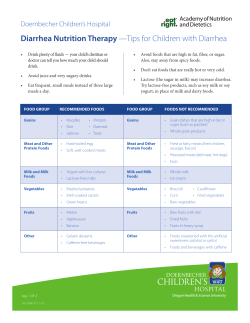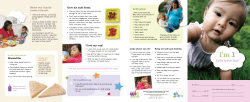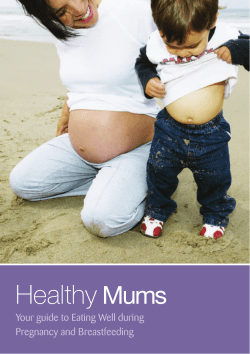
Pregnancy Healthy Moms + Babies Developing
Pregnancy Healthy Moms + Babies Developing Lifelong Habits Do I have to change the foods I eat? Foods you can eat: • Enjoy up to 12 ounces a week of fish and shellfish that are low in mercury–shrimp, salmon, tilapia, catfish and canned light tuna. • Continue to drink milk. If you feel bloated or have other digestive issues, try smaller amounts with meals, lactose-free milk, hard cheeses or yogurt. • Have up to 2 cups of brewed coffee or 5 cups of black tea each day. Too much coffee or other drinks high in caffeine could increase your risk of miscarriage. • Continue to follow a vegetarian diet if you eat eggs, milk and other milk products. If you are a strict vegan talk with your health care provider or a registered dietitian. Foods to avoid: These are not safe for your growing baby: • Raw or undercooked foods like eggs, sushi and fish. • Unpasteurized juices or milk (no raw milk). • Soft cheeses that are not pasteurized such as feta, Brie, blue-veined cheese or Mexican-style cheese like queso blanco and queso fresco unless the label says, “made with pasteurized milk.” • Fish with high amounts of mercury–shark, swordfish, king mackerel or tilefish. • Raw sprouts, especially alfalfa sprouts. • Alcoholic drinks, including beer and wine. Food safety: • Reheat until steaming hot: hot dogs, lunch meats and deli meats. • Wash fruits and vegetables well–even “prewashed” salad greens. • Check with your health care provider before you take any vitamins or supplements. 2 Am I really eating for two? How fast should I gain weight? How can I make sure I gain the right amount of weight during pregnancy? Focus on eating every day: 3 cups of Milk & Milk Products 2 ½ cups of Vegetables 2 cups of Fruits 6 ounces of Grains 5 ½ ounces of Meat & Beans This will provide most of the nutrients you need based on 2,000 calories. The chart below shows the amount of weight you should gain for a healthy pregnancy. It is based on your weight range before you became pregnant, called your pre-pregnancy weight. Pre-pregnancy weight Recommended weight gain* Underweight 28–40 pounds Generally you should gain 1–4 pounds during the first 3 months (the first trimester). Then aim for a weight gain of 1 pound each week for the rest of your pregnancy—and about half this amount if you are overweight. Gaining a pound a week is as simple as adding a snack each day. Try the snack ideas on Page 8 for healthy options. If you have sudden weight gain, contact your health care provider. To slow your weight gain: • Eat at least the recommended amounts from each food group. Don’t try to cut calories here! If it seems like too much food check your portion sizes on Page 4. • Choose low calorie but nutrient-rich foods like fat-free and low-fat milk, vegetables and fruits. For ideas, see the charts on Pages 4-5. Note that lower calorie foods are listed at the top, so eat smaller portions when choosing foods that are lower on the list. • Replace sugary drinks like soft drinks, sport drinks or sweetened tea with water, low-fat milk and unsweetened tea. To gain more weight: • Spread out your eating over the day, having 5 or 6 mini-meals to avoid getting full too fast. • Make simple changes to eat more calories: Normal weight 25–35 pounds Overweight 15–25 pounds Obese 11–20 pounds Add cheese or avocado to a sandwich. Snack on nuts, string cheese or dried fruit such as raisins. *if pregnant with one baby 3 What is healthy eating for my baby and me? What am I eating now? Using the food chart on these pages, mark how much food you ate and drank for meals and snacks yesterday. The serving sizes chart can help you. Write the amount you ate under “My Total” for each food group. How am I doing? Compare your totals to the “Goal.” Are there any gaps? If no, congratulations! If you are above or below the goal, the ideas at the top of Page 5 will help you adjust your foods. Symbol Serving Size Food One fist 1 cup Dry cereal, Milk,Yogurt, Vegetables, Fruit Palm 3 ounces Chicken, Beef, Fish, Pork Handful ½ cup Noodles, Rice, Oatmeal Two fists 2 cups Salad Thumb 1 tablespoon Peanut butter Pointer finger 1 ½ ounces Cheese Slice of Flat hand whole-wheat 1 slice bread oil, Thumb tip Cooking Mayonnaise, 1 teaspoon Butter, Sugar 4 Milk & Milk Products Choose low-fat or fat-free dairy most often What is 1 cup milk or yogurt Serving Size? 1 ½ ounces hard cheese Eat More Often Eat Less Often ___Low-fat cheese ___Fat-free milk ___String cheese ___Low-fat milk (1%) ___Reduced-fat milk (2%) ___Fat-free yogurt, plain ___Mozzarella cheese ___Low-fat yogurt, plain ___Whole milk ___Low-fat chocolate milk ___Low-fat cottage cheese ___Cheese: American, Cheddar, Jack and Swiss ___Pudding ___Cottage cheese ___Fat-free yogurt, flavored ___Custard or flan ___Frozen yogurt ___Ice cream Vegetables Vary your veggies Fresh, frozen or canned 1 cup raw or cooked 1 cup juice 2 cups raw leafy greens ___ Lettuce ___Spinach ___Peppers ___Broccoli ___Tomatoes, raw ___Bok choy ___Greens: collard, kale, mustard ___Asparagus ___Green beans ___Carrots ___Peas ___Squash ___Sweet potato ___Spaghetti sauce, no meat ___Potato ___Corn ___Avocado ___Oven-baked French fries My Total _______ TOTAL _______ TOTAL Goal* 3 cups 2 ½ cups Can small changes improve my health? Yes–small changes can make a big difference. Here are some ways: Choose some additional foods if you are coming up short in any food groups. Limit choices from the “extras,” which are often high in fat, salt or sugar and low in nutrients. Write down foods you will try and when you will try them to help meet your goals. For example, “I will eat a cup of yogurt (food) at breakfast (when).” _________________________________________________________________________________ _________________________________________________________________________________ Fruits Make most choices fruit, not juice Grains Make half your grains whole grain Fresh, frozen or canned in own juices 1 cup cut-up fruit 1 cup juice ¼ cup dried fruit 1 ounce = 1 slice bread; 1 cup dry cereal; ½ cup rice, pasta or cooked cereal ___ Hamburger or hot dog bun ___English muffin ___Whole-grain bread ___Hot cereal or oatmeal ___Roll ___Brown or white rice ___Pancake or waffle ___Corn tortilla ___Pretzels ___Pasta or noodles ___Whole-grain cereal ___Graham crackers ___Bagel ___Crackers ___French toast ___Flour tortilla ___Cornbread ___Granola ___Muffin ___Grapefruit ___Berries ___Papaya ___Peach ___Cantaloupe ___Orange ___Apricot ___Apple ___Pineapple ___Grapes ___Pear ___Raisins and other dried fruit ___Mango ___Banana ___Fruit juice (100 %) ___Canned fruit in syrup Meat & Beans Go lean with protein "Extra" Foods These don’t fit in a food group 3 ounces meat, fish or poultry 1 ounce = 1 egg; ½ cup beans; 1 tablespoon peanut butter or ½ ounce nuts Eat less. These are often higher in calories, added fats, salt or added sugars and low in nutrients. ___Beans: pinto, black ___Egg ___Tofu ___Shrimp and shellfish ___Peanut butter ___Tuna fish ___Pork and ham, lean ___Chicken and turkey (white meat, no skin) ___Fish ___Fish, fried ___Nuts and seeds ___Beef, lean ___Chicken, fried ___Sausage ___Ketchup ___Barbecue sauce ___Jelly/jam ___Salad dressing ___Bacon ___Mayonnaise ___Fruit drink ___Chocolate candy ___Cookies ___Potato chips ___Soft drink ___Cake ___Pie ___Doughnut ___Fast-food French fries _______ TOTAL _______ TOTAL _______ TOTAL ____ TOTAL 2 cups 6 ounces 6 ounces Limit amount *Based on a 2,000-calorie diet; your needs may be higher, especially in the 2nd and 3rd trimesters. 5 Pregnancy is an exciting time! How can I feel better? Nausea Constipation • Eat smaller meals 5 or 6 times a day. • Drink 8-12 cups (8 ounces each) of water, milk, 100 percent juices and broth soup each day. • Eat crackers or dry cereal before getting out of bed in the morning. • Eat a light snack just before going to sleep–a graham cracker and a glass of milk, or fruit and string cheese. • Skip coffee if your stomach feels upset. • Avoid stale or strong odors. Call your health care provider if you experience severe nausea and are unable to eat or hold down fluids. Heartburn • Eat frequent, small meals along with small amounts of fluid. • Eat slowly. • Limit foods that are spicy, high in fat, fried or produce gas (beans). • Don’t bend over or lie down, right after eating. Swelling • Eat fewer salty foods. Check sodium on food labels. • Lie down or prop up your legs and feet when you can. • Drink more, not less, water to help flush out extra fluids. • Wear comfortable shoes and if you are standing or sitting for a long time wear support panty hose. 6 • Eat lots of high fiber foods like whole grains, dried beans, lentils, fruits and vegetables. • Be active. How else can you help with these health issues? Move more! Activity helps to prevent you from gaining too much weight and can help with constipation, swelling and feeling tired. It can even help you get in shape for the day you deliver your baby. Check with your health care provider for approval on your activity routine. Aim for 30 minutes of moderate intensity activity on most days of the week. Use common sense when choosing what to do. If you haven’t been active, start slowly with an activity you enjoy and work up to 30 minutes. Great pregnancy activities are those that don’t involve contact or risk losing your balance, especially later in pregnancy. Remember to stop activity if you feel any discomfort. Activities to try: • Fast walking • Swimming • Low-impact aerobics • Prenatal Yoga • Stationary bicycling Small changes can make a big difference Write down your ideas here and think about when you will do them during the day. ______________________________________ ______________________________________ ______________________________________ What changes once the baby arrives? For you as a mom … Food Good nutrition is still important. Having a newborn may require you to plan your meals ahead of time. It’s very important not to skip meals. For example, people who skip breakfast are more likely to gain weight. Breast-feeding To stay hydrated, drink before you feel thirsty. You need up to 12 cups of fluids daily. Foods change the taste of your breast milk, so enjoy a wide variety of foods. This can help your baby enjoy more foods when beginning table food. Avoid alcohol and limit caffeine because these pass through breast milk to your baby. Losing weight Pregnancy weight gain took 9 months, so losing the weight may take just as long. Use these weight loss tips: • Breast-feeding may help you lose weight. • Eat from all 5 food groups and limit “extras.” • Include regular physical activity. • Skipping meals can lead to overeating later in the day. Eat 3 meals a day and healthy snacks if needed. For your baby … Food Breast milk provides ideal nutrition until your baby is 1 year old. Support from family, friends and your health care provider can help you to breast-feed. • Breast milk improves your baby’s immune system and lowers the risk of their becoming obese or getting diabetes. • Breast-feeding lowers your risk of breast and other cancers and helps you bond with your baby. • Breast-fed babies may need vitamin D drops. Ask your health care provider. Preventing allergies If you avoid foods like eggs, milk and nuts when breast-feeding, you may increase your baby’s risk of allergies later on, so be sure to eat these foods if you can. 7 Healthy foods for an important time. Try these simple ideas for good nutrition: • Low-fat yogurt mixed with fruit, nuts or granola • Greek yogurt mixed with dry ranch dressing and raw vegetables for dipping • Black beans, corn and tomato salad • Green salad topped with chunk light tuna, tomato, shredded cheese and salad dressing • Hummus, vegetables and crackers My health goals What will you add to your plate? Pregnancy is a perfect time to improve your habits. Here are goal ideas for both you and your baby’s good health: 1. Eat nutrient-rich foods from all 5 food groups. 2. Plan ahead so you do not skip meals or snacks. 3. Gain the recommended amount of weight. 4. Make time for regular physical activity. n make Small, easy changes I ca for good health: 1. 2. This program aligns with the 2010 Dietary Guidelines for Americans. It is one of many nutrition education resources offered by Dairy Council of California for students and adults to improve eating habits. For more information and additional resources, visit HealthyEating.org ©1990 DAIRY COUNCIL OF CALIFORNIA, rev 2013 PR210/277,000/07-13/TOP
© Copyright 2025





















